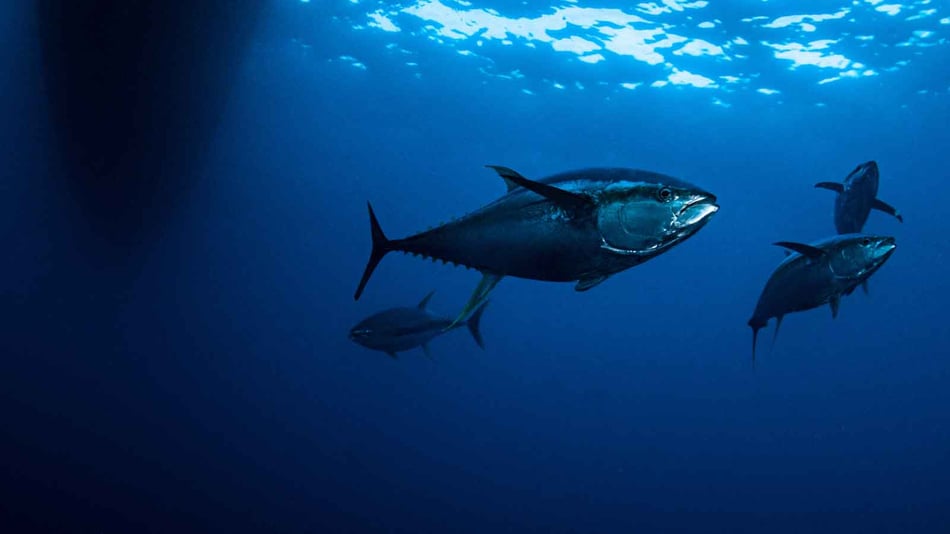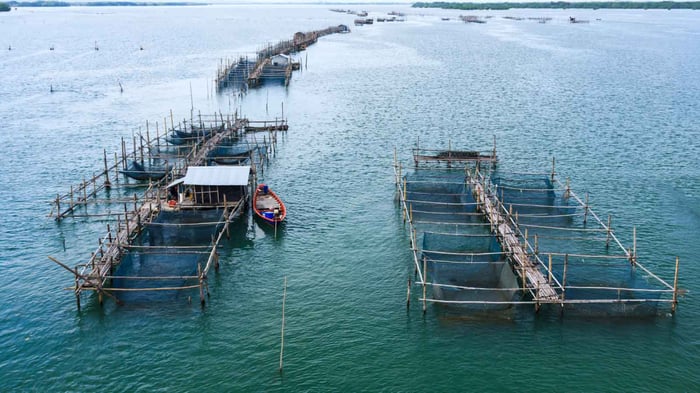The Truth About Tuna: Japan's Sustainable Farming Secrets Exposed!

Tin
4
min. read

In the heart of Japan, the gleaming silver scales of tuna have long mirrored both its rich cultural heritage and its economic vigor. This fish, celebrated in dishes from sushi to sashimi, is more than just a culinary delight; it is a symbol of Japan's reverence for nature, and a significant economic linchpin. Because the demand and enjoyment for the fish is deep and vast, there is now a call for sustainable farming solutions to ensure we can continue to enjoy this fish. It's not just about conserving a species, but about preserving the history, taste, and memories that are associated with the fish.
In the waters surrounding Japan, fishing for tuna isn't just an occupation; it's a tradition passed down through generations. Historically, fishermen used Ippon-zuri, or the single-hook fishing method. Setting out to sea in wooden boats, they would await the tuna, relying on intuition and experience to catch the fish. This was sustainable, respectful, and in tune with the natural patterns of the ocean.
But as word spread about the delights of tuna and the global appetite grew. Japan's culinary secret was out! By the 20th century, demand skyrocketed, leading to advanced fishing techniques and larger vessels to meet the need.
This surging demand had a ripple effect: tuna numbers began dwindling, with this decrease affecting not only hungry consumers but life underwater as well. The lessening presence of such a high-level predator also affects the balance of marine ecosystems as tuna are essential for keeping numbers of smaller marine species in check.
Similarly, there are also economic implications that come with lessened tuna numbers. The cost of catching the fish due to extended fishing expeditions and the price of the fish itself increases significantly, which, of course, has an effect on the totality of the economic market.
This is why there was an imperative need for a change in farming practices to integrate what we knew about sustainability. Japan, with its ability to innovate and its deep respect for the fish, was sure to find a way to sustainably change tuna farming practices.

Introduction to Full-Cycle Aquaculture
Full-cycle aquaculture, often termed the 'holy grail' of sustainable fishing, revolves around the idea of breeding and raising tuna in controlled environments instead of catching them in the wild. This method seamlessly melds age-old fishing traditions with cutting-edge science, creating a cycle where tuna are born, grow, and reproduce without ever setting fin in the vast oceans. One such example is the Sojitz Tuna Farm Takashima which is a Japanese producer of premium Takashima Bluefin Tuna. The 40,000 bluefin tuna that are being raised at the farm are housed in 33 fish cages, and the farm has expanded to the point where 10,000 fish are shipped each year.

Benefits of Farming Tuna in Controlled Environments
One of the shining benefits of this innovative farming method is the reduction in pressure on wild tuna stocks. When tuna are bred within fish farms, the need to cast vast nets into the open ocean diminishes, allowing wild populations a chance to rejuvenate and thrive.
The unpredictability of open-sea catches, influenced by factors like weather and migratory patterns, can also be sidestepped. In controlled environments, harvests become more predictable, ensuring a steady supply for the insatiable global appetite for tuna.
A controlled setting offers a unique advantage: overseeing the health and diet of the tuna. This not only ensures top-quality fish for consumers but also reduces the risks of diseases that can sometimes plague wild populations. Traditional fishing methods often inadvertently capture and kill non-target species—a grave environmental concern. Farming tuna sidesteps this issue, making the process ecologically friendlier.
How Advancements in Technology are Enabling More Sustainable Practices
With the integration of technologies like sensors can monitor water quality, temperature, and tuna health in real-time. These continuous data streams allow for immediate adjustments, ensuring optimal conditions for the tuna. One of the challenges in aquaculture is overfeeding, leading to waste and water pollution. Advanced automated systems now use cameras and algorithms to determine when and how much to feed the tuna, optimizing feed use and reducing waste.
Additionally, groundbreaking research into tuna genetics can potentially lead to breeds that grow faster and are more resilient, making them ideal for aquaculture. Moreover, understanding genetics ensures maintaining genetic diversity, critical for the overall health of tuna populations.
Japan's achievements, like the Kindai Tuna project, which utilizes all the methodologies listed above, have showcased the viability of full-cycle aquaculture. Japan is a beacon of sustainable aquaculture. By sharing its innovations and setting high standards, Japan is steering the world towards a future where the oceans remain bountiful and the seafood on our plates is both delectable and responsible.
Sustainable tuna farming isn't just a contemporary trend for Japan; it's a lifeline to preserving a cherished legacy. By embracing sustainable aquaculture, Japan not only safeguards its marine ecosystems but also fortifies its economy against the volatile currents of global seafood markets.

But the oceans know no borders. Just as the currents interweave across the vast expanse, so too must global efforts in championing sustainable fishing. Japan's pioneering spirit can serve as a lighthouse, guiding nations worldwide toward responsible and innovative practices.
Much like the pioneering efforts in Japanese sustainable tuna farming, IMARCS works to implement mariculture solutions that hold the potential to change our approach to ocean conservation. Inspired in part by the success of sustainable tuna farming, IMARCS is driven by a vision to harness the power of marine science to make the most out of marine ecosystems and create better environmental sustainability in the process.
References:
Bluefin Tuna Farming: The Future of Sustainable Seafood. (2023, April 30). Global Seafoods North America. Retrieved August 14, 2023, from https://globalseafoods.com/blogs/news/bluefin-tuna-farming-the-future-of-sustainable-seafood
Japanese Science and Technology Agency (JST), J. S. (n.d.). Yellowfin tuna fry successfully raised in ocean-surface fish preserve: Ellowfin Tuna Fry Successfully Raised in Ocean-surface Fish Preserve: https://www.jst.go.jp/pr/announce/20150924/index_e.html
Kimura. (2022, March 21). Running Out of Tuna? How Tuna Farming is Changing the Future Landscape of Marine Resources | caravan Discovering new colors of the world. Discovering New Colors of the World. Retrieved August 14, 2023, from https://www.sojitz.com/caravan/en/special/tuna/1.html
Levvitt. (2016, May 2). Overfishing puts $42bn tuna industry at risk of collapse. The Guardian. Retrieved August 14, 2023, from http://www.theguardian.com/sustainable-business/2016/may/02/overfishing-42bn-tuna-industry-risk-collapse
McCurry, J. (2008, November 18). Still hooked: time runs out for Japan’s dangerous obsession with the bluefin. The Guardian. http://www.theguardian.com/environment/2008/nov/18/fishing-japan-conservation-tuna
Mekata, M. (2015, May 3). Kinki University leads way in aquaculture evolution. The Japan Times. https://www.japantimes.co.jp/news/2015/05/03/national/kinki-university-leads-way-aquaculture-evolution/
O’Donncha, F., & Grant, J. (2019, December). Precision Aquaculture. IEEE Internet of Things Magazine, 2(4), 26–30.
Shen, Y., & Yue, G. (2019, March). Current status of research on aquaculture genetics and genomics-information from ISGA 2018. Aquaculture and Fisheries, 4(2), 43–47.